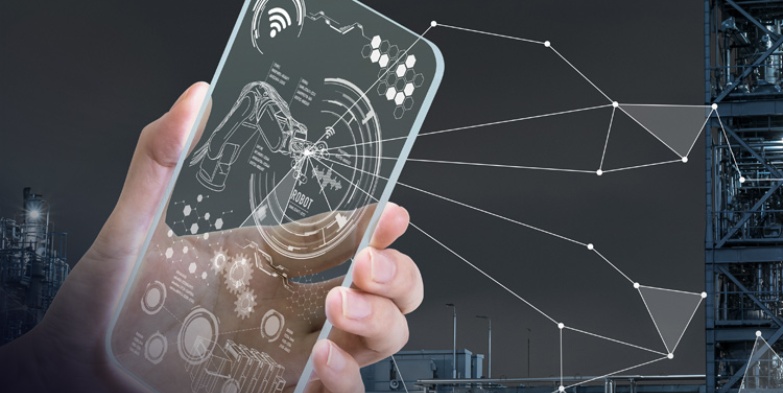
The internet of things (IoT) is the network of physical devices, vehicles, buildings and other items—embedded with electronics, software, sensors, actuators, and network connectivity that enable these objects to collect and exchange data. In 2013 the Global Standards Initiative on Internet of Things (IoT-GSI) defined the IoT as “the infrastructure of the information society.” The IoT allows objects to be sensed and controlled remotely across existing network infrastructure, creating opportunities for more direct integration of the physical world into computer-based systems, and resulting in improved efficiency, accuracy and economic benefit.
Internet of Things (IoT) is the key to the next phase of the industrial revolution. Technology allows physical devices to be brought into the digital domain. IoT is the idea of the fusion of the “real world” with the “digital world”, allowing devices or individuals be in constant communication and interaction, either with other people, objects or electronic devices. With the Internet of things, objects can be activated and controlled remotely through an existing network infrastructure. IoT is not science fiction anymore, the power of internet connectivity has gone beyond smart-phones and computers. Now, the internet is being used in all smart devices which are aimed to resolve actual real-world problems, from smart-watches to driver-less cars.
Looking ahead, the following are the ways IoT will transform the world in the near future:
Smart Homes
Perhaps this is the most talked about application of IoT, for the right reasons. The vision of a smart home is for the owner to be able to control and monitor home appliances such as lights, security cameras, fridges, ovens, water flow from taps, and home security among many others remotely using his mobile phone/tablet/laptop. Isn’t that awesome? Imagine a situation where you forgot to turn off a water tap in your kitchen; you are already miles away from your house. With IoT, you can just turn it off from your phone.
Smart Cities
Smart City or “City of the Future” is a concept that foresees technology being used to bring about drastic improvements in urban infrastructure aimed at making urban centers more efficient, cheaper and better to live in. The idea of “Smart City” is to address planning and public administration through the automation of services in a creative and sustainable way. The sectors that will be transformed first in the wake of smart cities are government services, transport and traffic management, energy, health care, water, innovative urban agriculture, and waste management
Smart Cars
They might not yet be here with us, but trust me; soon they will be all over. Imagine controlling all the functionalities of your car using your smart-phone? Having on board a smart computer that programs all your preferences; integrated sensors to alert mechanical assistance; and even a system capable of driving the car for you? This is no longer science fiction, within a few years you will see such cars on the road. Central computers installed in the car will be receiving data from sensors installed in different components of the car to determine engine oil level, radiator water temperature, among other things.
Smart grids
Another industrial application of IoT is the smart/intelligent grid. The grid will enable real-time surveillance of energy supply and demand information. It will use computer intelligence to manage resources efficiently. Utility companies will therefore use IoT smart grid technologies for more efficient outage management. Once an intelligent connection system is developed for the manufacturing of energy, transmission, distribution and consumption of the electricity network, data about the state of the network will be communicated to system users, operators and automated devices, enabling them to plan ahead and fix any outage.
IoT in Agriculture
Farmers will be able to use intelligent IoT farming applications to optimize the many distinct agricultural operations such as determining the best time to harvest crops, generating soil composition-based fertilizer profiles and detecting soil nutrients and moisture concentrations. A series of sensors will be installed throughout the farm-land. Sensors will also be connected to animals to help control livestock. For instance, a microchip attached to a camel’s ear will track the animal, store its vaccine history, among other information.

10 thoughts on “IoT: How the future looks like”
I will recommend your beautiful post site to my friends Sidonnie Meredeth Vas
When I originally commented I clicked the “Notify me when new comments are added” checkbox and now each time a comment is added I get three emails with the same comment.
Is there any way you can remove me from that service? Bless you!
magnificent put up, very informative. I wonder why the other specialists of this sector do not realize this. You should continue your writing. I am confident, you’ve a huge readers’ base already!
Theres no need to fear the wind if your haystacks are tied down.
Strife is better than loneliness.
The race is not to the swift nor the battle to the strong.
Charm is more than beauty.
Experience is a comb which nature gives to men when they are bald.
Six hours sleep for a man seven for a woman and eight for a fool.
A powerful share, I just given this onto a colleague who was doing a little analysis on this. And he in reality purchased me breakfast because I discovered it for him.. smile. So let me reword that: Thnx for the treat! But yeah Thnkx for spending the time to debate this, I really feel strongly about it and love reading more on this topic. If attainable, as you change into experience, would you mind updating your blog with more particulars? It’s highly helpful for me. Big thumb up for this weblog submit!